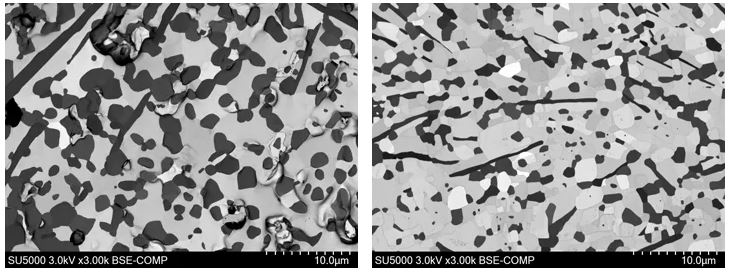Cryogenic ion milling of a fuel cell Membrane Electrode Assembly (MEA)
using the ArBlade5000 with Cryo Temperature Control
using the ArBlade5000 with Cryo Temperature Control
The Membrane Electrode Assembly (MEA) is a main part of the fuel cell: its bonding condition of each layer and the aggregation state of particles influence the power generation performance. Structural observation of the MEA cross section is therefore important. Such samples require additional preparation steps before SEM imaging. Ion milling is used as a sample preparation technique to polish sensitive samples without mechanical stress. To reduce heat damage by ion beam irradiation, cryogenic ion milling is applied. The ArBlade5000 ion milling system from Hitachi provides a cryogenic option to actively cool during cross-section milling.

Figure 1. Cross section SEM images of a fuel cell MEA after cryogenic ion milling. (A) whole image of the MEA showing the anode, electrolyte membrane and the cathode (x3.50k), (B) the anode layer, x100k mag. (C) the cathode layer, x100 mag.
Fuel cell MEAs consist of multiple layers: an anode and cathode are separated by an electrolytic membrane. Figure 1a shows a cross-section of a MEA after cryogenic ion milling. The layers are in contact without any delamination. In the highly magnified image of the anode (Figure 1b), nanometer sized platinum (Pt) and carbon particles are visible with many voids. The cathode layer is examined in Figure 1c with a magnification of 100k. This layer consists of catalyst capsules with combined Pt-Fe nanoparticles. High resolution SEM imaging reveals that these capsules are closely packed. This cryogenic ion milling method, which can process without stress, enables to produce cross-sections of samples with reduced thermal damage using its cooling function. These results demonstrate that cryogenic ion milling is beneficial for the examination of fuel cell MEAs and to analyze its nanostructures.
About cryogenic ion milling:
The ArBlade5000 with Cryo Temperature Control (CTC) enables the user to set a desired temperature between 0°C and -100°C. The temperature is accurately measured and maintained during the process. After cryogenic ion milling, the temperature of the specimen stage is raised slowly to prevent ice formation or water condensation.
Especially highly temperature sensitive samples with a low thermal conductivity should be treated with care, to conduct the generated heat to other areas of the specimen. For this reason, the ArBlade5000 provides low accelerating voltages for less aggressive cryogenic ion milling. An example of such a sample, a wood alloy, is shown in Figure 2. These images are obtained with the SU5000 from Hitachi.

Figure 2. Differences between regular ion milling (left) and cryogenic ion milling (right), x3.0k mag.